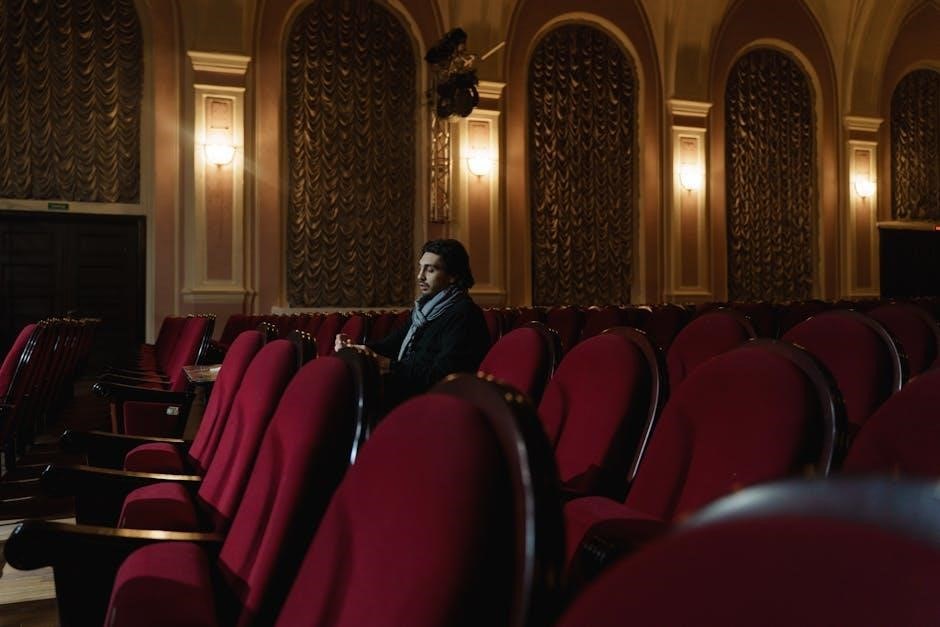The play, based on Anne Frank’s diary, captures her two-year hiding experience from Nazis. Premiering on Broadway in 1955, it’s now available as a PDF script.
Overview of the Play
The play, adapted from Anne Frank’s diary, recounts her family’s two-year hiding from the Nazis in Amsterdam. Set in the Secret Annex, the play captures the challenges and emotions of eight people in confinement. It is divided into acts, with the option to perform without an intermission. The drama highlights the claustrophobic conditions, interpersonal tensions, and the enduring hope of the characters. Faithful to Anne’s diary, the script also includes descriptions of the set and music, offering a vivid portrayal of life during the Holocaust.
Historical Context of Anne Frank’s Diary
Anne Frank’s diary chronicles her life as a Jewish teenager during World War II, documenting the Nazi occupation of the Netherlands; From 1942 to 1944, Anne and her family hid in the Secret Annex in Amsterdam to escape persecution. The diary captures the daily struggles, hopes, and fears of those in hiding. Tragically, Anne and her family were discovered and deported to concentration camps. Anne died in 1945, just before the camp’s liberation. Her diary, preserved by Miep Gies, became a powerful testament to the Holocaust’s horrors and a symbol of resilience.
Adaptation from Diary to Play
Frances Goodrich and Albert Hackett adapted Anne Frank’s diary into a powerful stage drama, premiering on Broadway in 1955. The play captures the claustrophobic atmosphere of the Secret Annex, focusing on key moments from the diary. While faithful to Anne’s voice, the adaptation condenses her thoughts and experiences into a coherent narrative, emphasizing character dynamics and emotional depth. The play retains the diary’s essence, offering a heart-wrenching portrayal of hope and resilience amidst war. The script is widely available in PDF format, making it accessible for performances and educational purposes, ensuring Anne’s story continues to resonate globally.

Background of the Play
The play, adapted from Anne Frank’s diary, tells the story of eight people hiding during WWII. It captures their struggles, hopes, and resilience, preserving her legacy.
The Original Diary and Its Significance
Anne Frank’s diary is a heartfelt, intimate account of her life in hiding during WWII. Written between 1942 and 1944, it captures her emotions, hopes, and struggles; The diary, discovered by Otto Frank after the war, became a global symbol of resilience and hope. Its raw honesty and depth provide a unique perspective on the Holocaust, making it one of the most important historical documents of the 20th century. The diary’s universal themes of humanity and courage have inspired millions, ensuring its enduring relevance and impact.
Anne Frank’s Life and Legacy
Anne Frank was a young Jewish girl born in Frankfurt in 1929. She fled to Amsterdam with her family to escape Nazi persecution. During WWII, Anne and her family hid in a secret annex, where she wrote her diary. Tragically, Anne died in a concentration camp in 1945, just before liberation. Her diary, preserved by her father, Otto, became a global symbol of hope and resilience. Anne’s legacy endures through her writings, inspiring millions to reflect on humanity, tolerance, and the Holocaust. Her story continues to educate future generations about the importance of peace and understanding.
The Holocaust and Its Impact on the Story
The Holocaust, a tragic period of genocide during WWII, deeply shaped Anne Frank’s story. Her diary and the play reveal the horrors faced by Jews under Nazi rule. Anne and her family were forced into hiding to escape persecution, their lives confined to a secret annex. The Holocaust’s brutality interrupted their hopes for a normal future, leading to Anne’s eventual capture and death. The play vividly portrays the emotional toll of living in constant fear, making the Holocaust’s impact central to the narrative. Its historical significance ensures the story remains a powerful reminder of humanity’s darkest chapter.

The Playwrights and Their Vision
Frances Goodrich and Albert Hackett collaborated to adapt Anne Frank’s diary into a powerful play. Their vision was to preserve her spirit and the Holocaust’s historical significance.
Frances Goodrich and Albert Hackett
Frances Goodrich and Albert Hackett, a husband-and-wife team, adapted Anne Frank’s diary into a play. Their collaboration brought emotional depth and historical accuracy to the story. Premiering in 1955, their work captured the essence of Anne’s spirit and the Holocaust’s impact. The play’s success lies in their ability to balance personal narratives with broader themes. Their dedication to preserving Anne’s legacy ensured her story reached global audiences, making it a cornerstone of Holocaust education and theatrical history. Their vision remains a testament to the power of storytelling.
Their Approach to Adapting the Diary
Frances Goodrich and Albert Hackett meticulously adapted Anne Frank’s diary into a powerful play, ensuring the integrity of her voice and story. They focused on capturing the emotional depth of life in the Secret Annex, blending personal struggles with universal themes. The playwrights maintained historical accuracy while transforming the diary’s intimate entries into a compelling dramatic narrative. Their adaptation preserved the essence of Anne’s hope and resilience, creating a timeless theatrical experience that honors her legacy and educates audiences about the Holocaust.
Key Themes in the Play
The play explores themes of hope, resilience, and the human spirit in crisis. It highlights the struggle for humanity and dignity in the face of oppression. The diary’s importance as a survival tool and a means of preserving identity is central. Themes of family, sacrifice, and the psychological toll of confinement are also prominent. The play underscores the universal message of hope and the enduring strength of the human spirit, even in the darkest times, making it a powerful reflection on humanity and survival.

Structure of the Play
The play maintains a single setting in the Secret Annex, structured into two acts, with the option to include an intermission for dramatic pacing and reflection.

Acts and Scenes in the Play
The play is divided into two acts, maintaining a single setting in the Secret Annex. Act I introduces the characters and their hiding place, while Act II explores their struggles and hopes over time. The acts are designed to reflect the passage of months, with scenes capturing key moments of tension, joy, and despair. An optional intermission allows for dramatic pacing, emphasizing the emotional journey. The structure highlights the characters’ growth and the escalating external dangers, creating a powerful narrative flow that engages audiences deeply.
The Setting: The Secret Annex
The play is set entirely in the Secret Annex, a hidden space above Otto Frank’s office in Amsterdam. This confined environment, with its sharply peaked roof and limited quarters, creates a claustrophobic atmosphere. The Annex consists of four rooms, depicted in detail in the script. The setting remains unchanged throughout, emphasizing the characters’ isolation and the passage of time. The physical constraints of the space mirror the emotional and psychological struggles of those hiding, amplifying the tension and intimacy of their shared experience during World War II.
Character Development
The play masterfully portrays the growth and emotional journeys of its characters. Anne evolves from a lively teenager to a mature young woman, grappling with hope and despair. Her relationship with Peter transitions from rivalry to deep connection, reflecting their shared isolation. Otto Frank’s paternal strength and Edith’s quiet resilience are contrasted with the tensions between characters like Mr. Dussel and the Van Daans. The confined setting amplifies their personalities, revealing their struggles, fears, and humanity. Through dialogue and interaction, the script captures the complexity of living in constant fear, fostering empathy and understanding of their plight.

Characters in the Play
The play features eight characters, including Anne Frank, her family, and their allies. Each character’s unique personality and background shape their interactions in the Secret Annex.
Anne Frank: The Protagonist
Anne Frank, a 13-year-old Jewish girl, is the heart of the play. Her diary serves as her confidant, capturing her hopes, fears, and resilience while hiding from the Nazis. Anne’s optimism and curiosity contrast the bleakness of her situation, showcasing her growth from a young girl to a reflective thinker. Her diary entries reveal her deep inner world, making her one of literature’s most relatable protagonists. Anne’s story transcends her circumstances, embodying universal themes of hope and humanity in the face of adversity.
Otto Frank: Anne’s Father
Otto Frank, Anne’s father, is a central figure in the play, embodying strength and resilience. He organizes the family’s hiding in the Secret Annex, ensuring their survival. His optimism and protective nature provide emotional support to Anne and others. After the war, Otto dedicates his life to spreading Anne’s message of hope. His character highlights the struggles of a father trying to shield his family from the horrors of the Holocaust, while his survival underscores his enduring legacy in preserving Anne’s diary for the world.
Edith Frank: Anne’s Mother
Edith Frank, Anne’s mother, is portrayed as a caring homemaker dedicated to her family. Her reserved nature contrasts with Anne’s vibrancy, often leading to tension. Edith’s primary focus is maintaining order and providing emotional support in the Secret Annex. She struggles with the confinement and the strain it places on family relationships. Her quiet strength and devotion to her daughters are evident, even as she faces the unimaginable challenges of hiding during the Holocaust. Edith’s character represents the emotional toll on mothers in crisis, striving to protect their children amidst unimaginable hardship.
Margot Frank: Anne’s Sister
Margot Frank, Anne’s older sister, is portrayed as mature and reserved, contrasting Anne’s lively nature. She often mediates between Anne and their mother, showcasing her responsible character. Margot’s quiet demeanor and focus on studies highlight her struggles with the confinement in the Secret Annex. Her relationship with Anne is complex, marked by both rivalry and moments of closeness. Margot’s character adds depth to the play, offering a unique perspective on life in hiding and the challenges faced by the Frank family during the Holocaust.
Miep Gies: A Key Ally
Miep Gies, a loyal and courageous helper, played a pivotal role in the survival of the Frank family. She risked her life to provide food, supplies, and emotional support to those in hiding. Miep’s visits to the Secret Annex brought hope and connection to the outside world. Her bravery and compassion were instrumental in sustaining the group during their ordeal. After the family’s arrest, Miep retrieved Anne’s diary, preserving her story for the world. Her selfless actions and unwavering dedication remain a testament to human kindness during one of history’s darkest periods.
Mr. Kraler: The Helper
Mr. Kraler, a trusted ally, played a vital role in the Frank family’s survival by assisting in securing the Secret Annex. Alongside Miep Gies, he provided essential supplies and support, risking his life to help the group evade Nazi detection. Kraler’s loyalty and bravery were crucial during their time in hiding. His efforts, though often behind the scenes, were instrumental in sustaining the group’s hope and resilience. Kraler’s character embodies the quiet yet profound impact of ordinary individuals who chose to act with extraordinary courage during extraordinary times.
Mr; Dussel: The Dentist
Mr. Dussel, a dentist and one of the eight people in the Secret Annex, shares a room with Anne Frank. His presence creates tension, particularly due to his complaints and strict adherence to routines. Despite his difficult nature, Dussel’s character highlights the challenges of living in close quarters under immense stress. His interactions with Anne, especially regarding the use of her desk for writing, reveal his lack of understanding of her emotional needs. Dussel’s role in the play underscores the complexities of human behavior during crisis, adding depth to the story’s emotional landscape.
Peter Van Daan: The Young Neighbor
Peter Van Daan is the son of the Van Daan family, who share the Secret Annex with the Franks. Initially awkward and shy, Peter evolves into a kind and supportive figure in Anne’s life. His relationship with Anne deepens over time, offering her emotional comfort amidst confinement. Peter’s character represents the struggles of adolescence under extreme circumstances, as he navigates his own identity and the harsh realities of their situation. His bond with Anne highlights themes of hope and human connection in the face of adversity.

Themes and Messages
The play explores themes of hope, resilience, and the human spirit during crisis. It emphasizes the power of diary-writing as a means of coping and preserving identity.
Hope and Resilience
The play vividly portrays Anne’s unwavering hope and resilience amidst the horrors of the Holocaust. Despite the confinement and constant fear, Anne’s diary entries reveal her optimism and belief in a better future. The Secret Annex, though cramped and precarious, becomes a symbol of resilience as the characters cling to hope. Anne’s determination to find beauty in darkness inspires those around her, illustrating the human spirit’s capacity to persevere. Her writings serve as a testament to the power of hope, even in the face of unimaginable adversity, leaving a lasting impact on the audience.
The Human Spirit in Crisis
The play powerfully explores the human spirit’s struggle during the Holocaust, revealing how individuals cope with extreme adversity. Confined to the Secret Annex, the characters face fear, tension, and uncertainty, yet their humanity endures. Anne’s diary entries reflect the emotional turmoil, while the group’s interactions reveal both conflict and compassion. The play highlights the fragility and strength of the human spirit, as the characters cling to hope and dignity amidst unimaginable suffering. This portrayal serves as a poignant reminder of humanity’s capacity to endure and find meaning in the darkest times, leaving a profound emotional impact on audiences.
The Importance of Diary-Writing
Anne Frank’s diary serves as a vital outlet for self-expression and reflection during her confinement. Through her writings, she processes emotions, documents daily life, and maintains hope. The diary becomes her confidant, offering solace and a sense of normalcy amidst chaos. Its pages capture the inner world of a young girl, revealing her growth, aspirations, and fears. The diary’s significance extends beyond personal reflection; it preserves a historical record of life in hiding and the resilience of the human spirit. This intimate form of writing underscores the universal power of storytelling and personal documentation.

Cultural and Historical Impact
The play has become a cornerstone in Holocaust education, offering a poignant look at WWII’s atrocities. Its availability as a PDF script ensures global accessibility and enduring relevance.
Reception of the Play
The play received widespread acclaim for its powerful portrayal of Anne Frank’s story. Its Broadway debut in 1955 was a critical and emotional success, resonating deeply with audiences. The 1997 Broadway revival, starring Natalie Portman, further cemented its impact. The play’s ability to convey hope, resilience, and humanity in the face of oppression has made it a timeless piece. Its adaptation into a PDF script has ensured accessibility for educators, students, and theater enthusiasts worldwide, preserving its historical and cultural significance for future generations.

Its Role in Holocaust Education
The play serves as a vital tool in Holocaust education, offering a poignant and personal perspective on one of history’s darkest periods. By adapting Anne Frank’s diary into a stage production, the play humanizes the victims of the Holocaust, making the atrocities relatable and accessible to students. The availability of the script in PDF format has further facilitated its use in classrooms, allowing educators to explore themes of hope, resilience, and humanity. This theatrical adaptation ensures Anne’s story continues to educate and inspire future generations about the importance of empathy and understanding.
Legacy of the Play
The play has left an indelible mark on theater and culture, becoming a cornerstone of Holocaust literature. Its adaptation into a PDF script has made it accessible worldwide, ensuring Anne Frank’s story reaches diverse audiences. The play’s emotional depth and historical significance continue to resonate, making it a timeless educational resource. Its legacy lies in its ability to evoke empathy and understanding, preserving the memory of the Holocaust while inspiring hope and resilience. The play remains a powerful tribute to Anne Frank’s enduring spirit and her profound impact on humanity.

Availability of the Script
The Diary of Anne Frank play script is widely available as a PDF, offering free downloads for educational purposes. Performance rights must be obtained through Dramatists Play Service.
PDF Versions and Accessibility
The Diary of Anne Frank play script is readily available in PDF format, offering easy access for readers and educators. Many websites provide free downloads of the full script, making it accessible for educational purposes. The PDF versions often include detailed descriptions of the set, such as the four-room layout of the Secret Annex, enhancing the play’s producibility. Additionally, some versions include music manuscripts for the two songs featured in the play. This accessibility ensures that the story of Anne Frank can be widely shared, preserving its historical and emotional impact for future generations. The PDF format allows for convenient reading and printing, making it a popular choice for schools and theater groups.
Performance Rights and Permissions
Performing The Diary of Anne Frank requires obtaining permission from Dramatists Play Service, Inc. Non-professional productions must secure written consent and pay applicable fees. Professional performances also need licensing through the same agency. These requirements ensure the playwrights’ rights are protected and their work is respected. Permissions guarantee legal compliance and support the legacy of Anne Frank’s story. This process is essential for any production, whether amateur or professional, to honor the creators and maintain the play’s integrity.
The play script of The Diary of Anne Frank is a powerful adaptation of her diary, offering a poignant reflection on hope and resilience. Available as a PDF, it remains a vital educational resource, ensuring Anne’s story continues to inspire and educate future generations about the Holocaust and its impact.
Final Thoughts on the Play’s Significance
The Diary of Anne Frank play script is a timeless, deeply moving portrayal of hope, resilience, and the human spirit. Adapted from Anne’s diary, it captures the claustrophobic reality of hiding during the Holocaust while emphasizing the importance of hope and unity. The play’s significance lies in its ability to educate and inspire, offering a poignant reminder of the atrocities of war and the strength of the human heart. Its availability as a PDF ensures Anne’s story continues to resonate globally, fostering empathy and reflection across generations.
Encouragement to Read or Watch
Engaging with The Diary of Anne Frank play script is a deeply rewarding experience, offering insight into hope, resilience, and humanity. Reading the PDF script or watching a performance allows audiences to connect with Anne’s story on a profound level. It is a powerful educational tool for understanding the Holocaust and its impact on individuals. The play’s timeless themes inspire reflection and empathy, making it an indispensable piece for anyone interested in history, drama, or the human condition. Encourage others to explore this poignant story and its universal message of hope and courage.